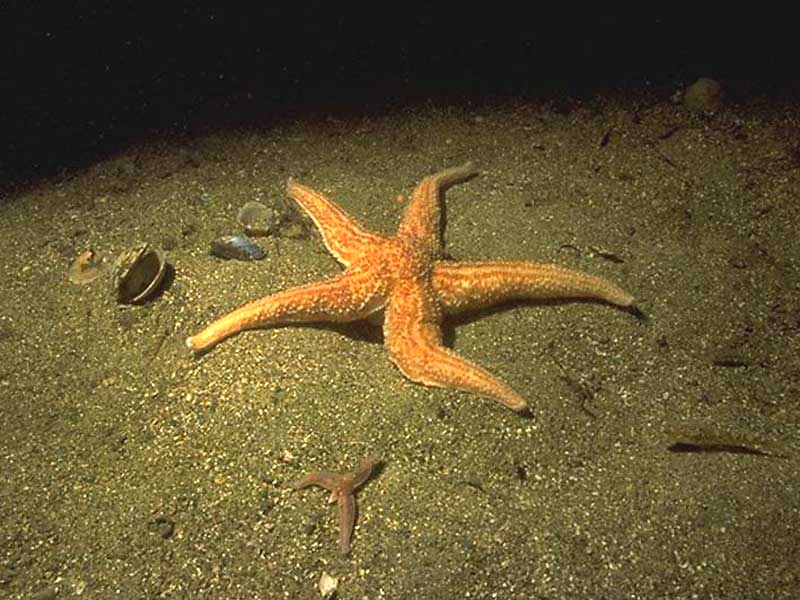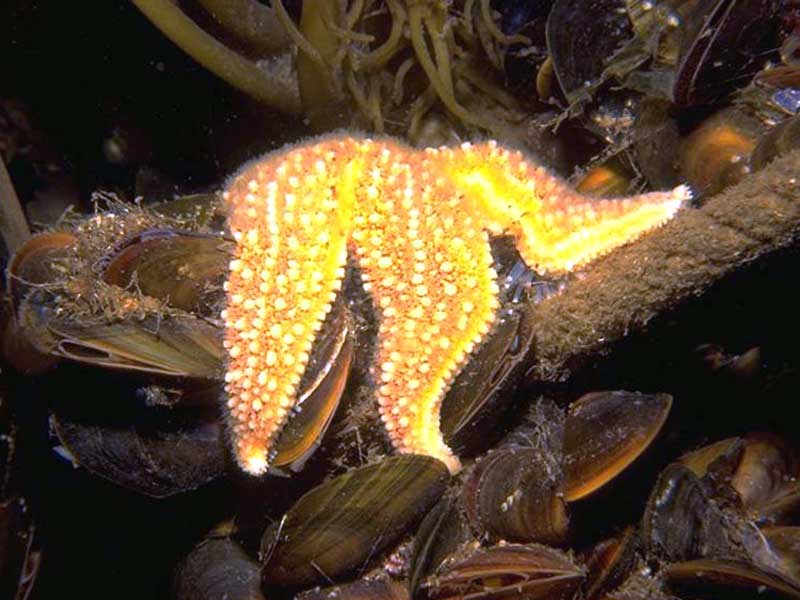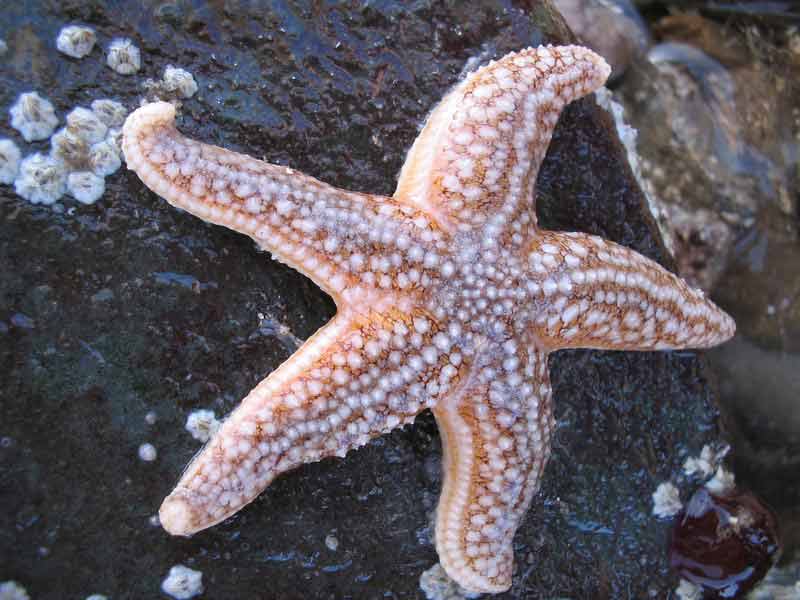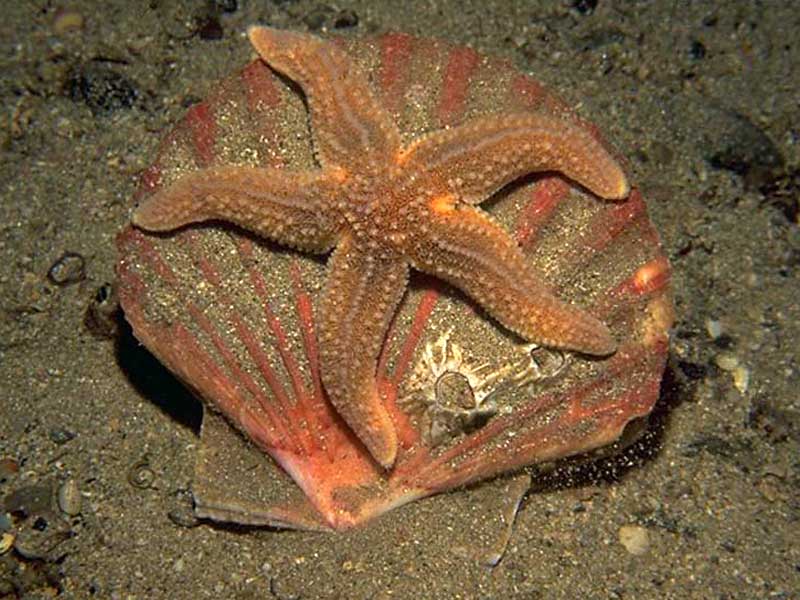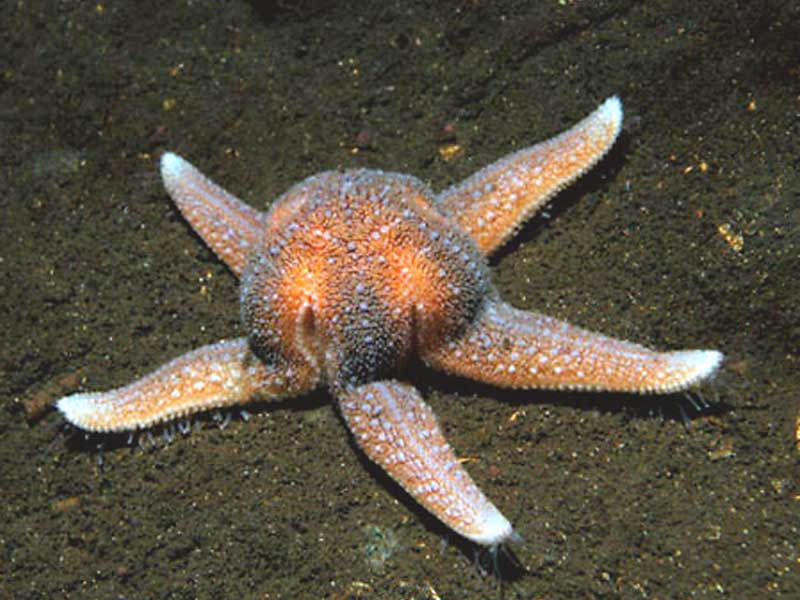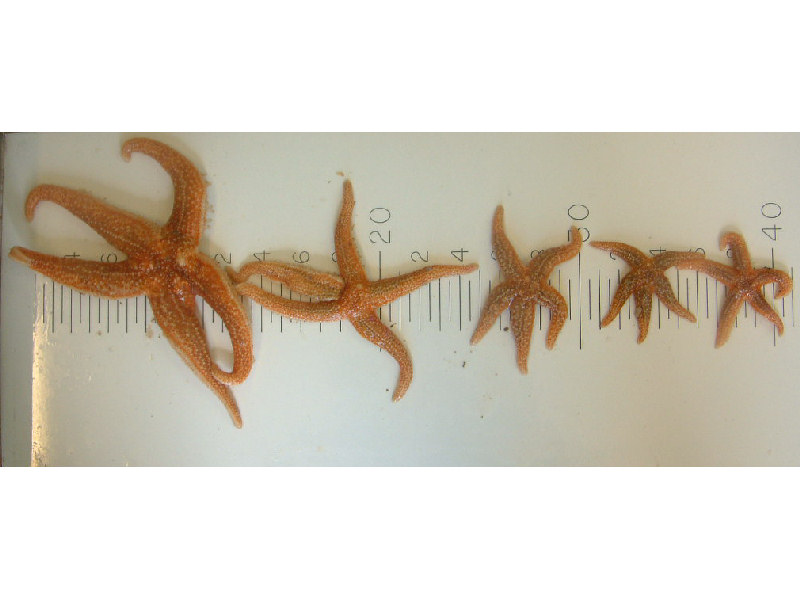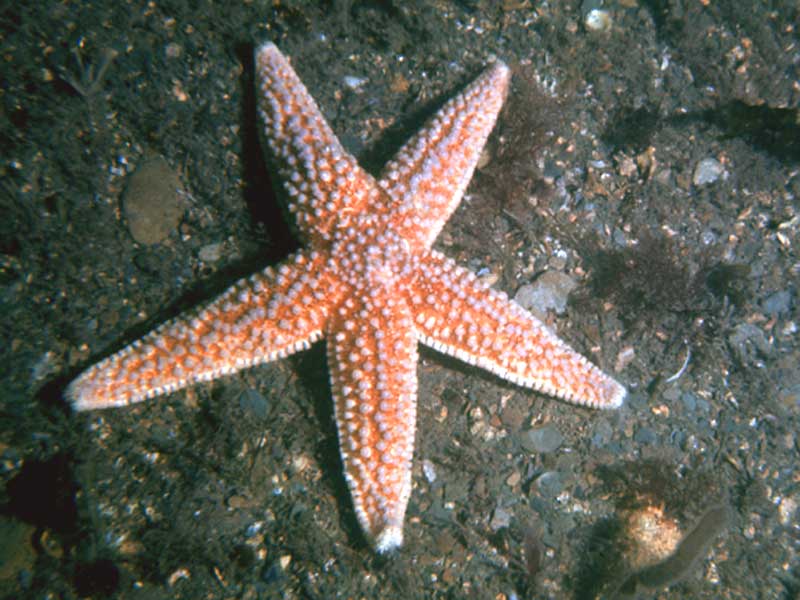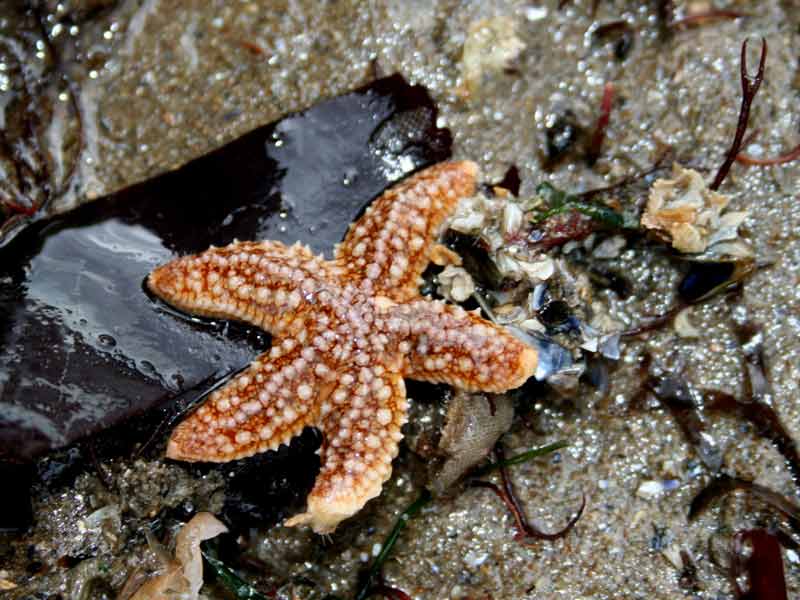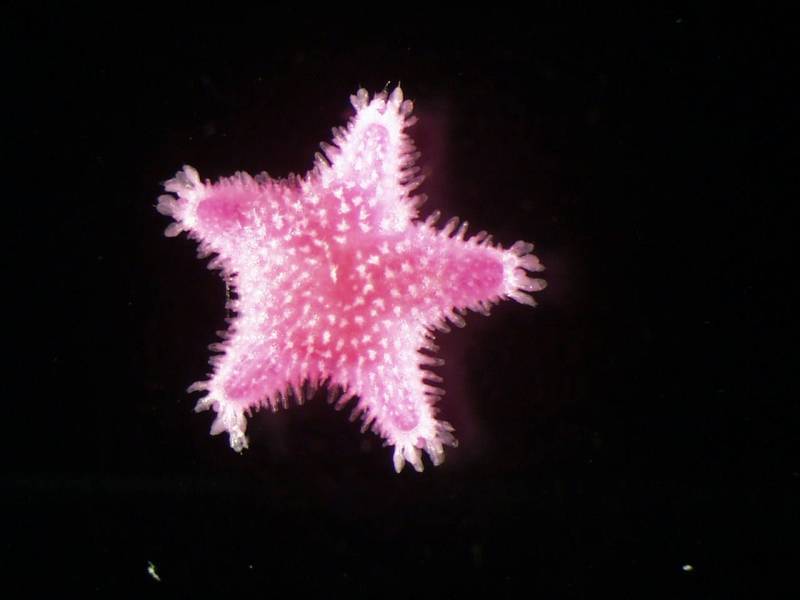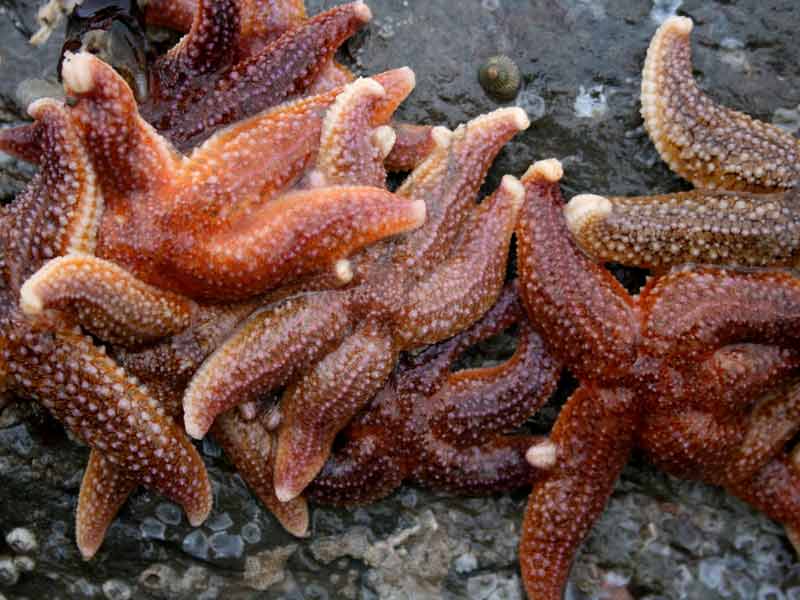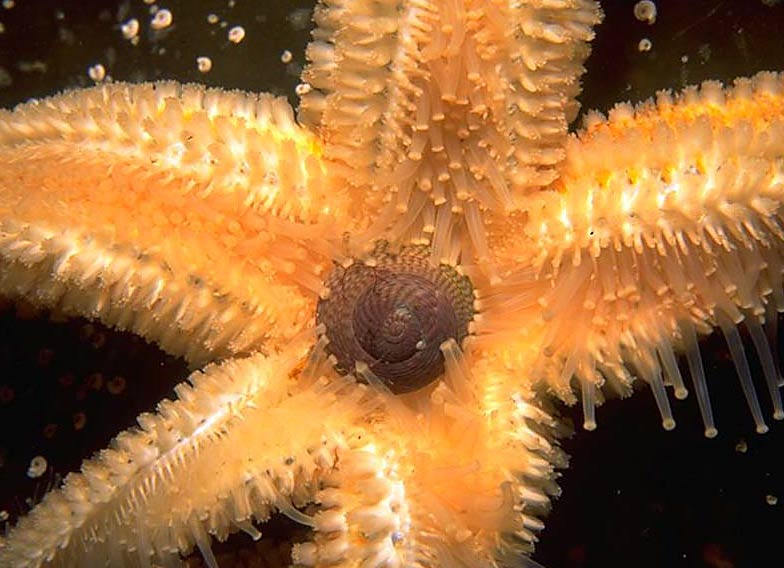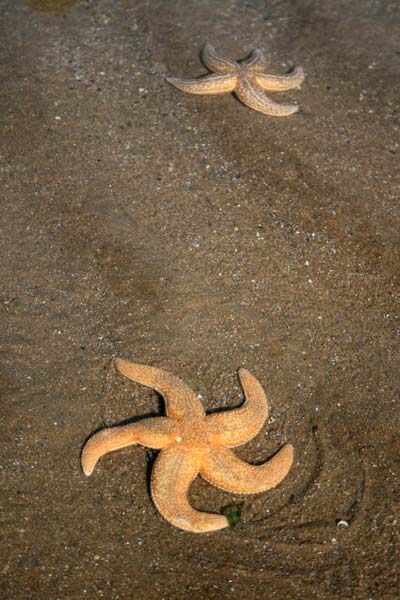Common starfish (Asterias rubens)
Distribution data supplied by the Ocean Biodiversity Information System (OBIS). To interrogate UK data visit the NBN Atlas.Map Help
| Researched by | Georgina Budd | Refereed by | Prof. David Nichols |
| Authority | Linnaeus, 1758 | ||
| Other common names | - | Synonyms | - |
Summary
Description
Asterias rubens is the most common and familiar starfish in the north-east Atlantic region. Asterias rubens may grow up to 52 cm in diameter, but commonly 10-30 cm. Asterias rubens is variable in colour, though usually orange, pale brown or violet. Deep-water specimens are pale. It has five tapering arms, broad at the base that are often slightly turned up at the tip when active.
Recorded distribution in Britain and Ireland
Found on all British and Irish coasts, especially amongst beds of mussels and barnacles.
Global distribution
Abundant throughout the north-east Atlantic, from Arctic Norway, along Atlantic coasts to Senegal, and only found occasionally in the Mediterranean (Mortensen, 1927)
Habitat
Asterias rubens occurs in varying abundance upon a variety of substrata that include coarse and shelly gravel and rock. Reported abundances vary between 2-31 Asterias rubens per m² on fine sand and 324-809 specimens on algal carpets (Anger et al., 1977).
Depth range
Intertidal to depths of 650 m.Identifying features
- Disc small, five arms (rarely 4-8).
- Body wall very flexible with numerous groups of papulae in soft areas.
- Major spines on the upper surface often in one or more longitudinal rows, sometimes surrounded by bundles of straight and crossed pedicellariae.
- Ventro-lateral spines just outside adambulacrals, in oblique rows.
- Straight pedicellariae on lower surface in ambulacral grooves and attached to furrow spines.
Additional information
- Asterias rubens is considered to be conspecific with Asterias vulgaris from the eastern seaboard of the United States of America and Canada (Coe, 1912).
- The size of Asterias rubens varies markedly with food availability and hence size is not necessarily a good indicator of age.
Listed by
- none -
Biology review
Taxonomy
| Level | Scientific name | Common name |
|---|---|---|
| Phylum | Echinodermata | Starfish, brittlestars, sea urchins & sea cucumbers |
| Class | Asteroidea | Starfish |
| Order | Forcipulatida | |
| Family | Asteriidae | |
| Genus | Asterias | |
| Authority | Linnaeus, 1758 | |
| Recent Synonyms | ||
Biology
| Parameter | Data | ||
|---|---|---|---|
| Typical abundance | Low density | ||
| Male size range | (Diameter) 10-50 cm | ||
| Male size at maturity | (Diameter) 50 cm | ||
| Female size range | (Diameter) 50 cm | ||
| Female size at maturity | |||
| Growth form | Radial | ||
| Growth rate | 0.2-1cm/month | ||
| Body flexibility | High (greater than 45 degrees) | ||
| Mobility | Crawler or Walker | ||
| Characteristic feeding method | Predator | ||
| Diet/food source | |||
| Typically feeds on | Bivalves, polychaetes, small crustaceans, other echinoderms and carrion. | ||
| Sociability | No information | ||
| Environmental position | Epibenthic | ||
| Dependency | Independent. | ||
| Supports | Host The caprellid amphipod Pariambus typicus, which is often found attached to the spines and a semiparasitic copepod Scottomyzon gibbosum. The male gonads may be parasitised by the ciliate Orchitophrya stellarum. | ||
| Is the species harmful? | No | ||
Biology information
Growth rate. There is considerable irregularity in the growth rate of starfish, especially during their first year.
- Vevers (1949) observed that with an abundant food supply, juvenile specimens of Asterias rubens could increase their radius at a monthly rate of slightly more than 10 mm in summer and autumn, and slightly less than 5 mm per month in winter.
- Orton & Frazer (1930) recorded an increase in diameter of 2.5 mm per month on average, and 5.0 mm per month maximum in Asterias rubens.
- Nichols & Barker (1984 b) followed the growth of annual cohorts in a population of Asterias rubens on an intertidal reef in Torbay, South Devon, UK, for three years. Growth was most rapid in the year following settlement and during the warmer months of the year. The average increase in starfish diameter over the first year was 28.5 mm and over the second 13.0 mm. The mean monthly increase in diameter over the three-year period of the study was 2.2 mm. Starfish on the reef became sexually mature in their second year after attaining a diameter of 5 cm.
Under conditions of poor food supply the growth of Asterias rubens is limited and specimens may decline in size (Hancock, 1958). Vevers (1949) reported a specimen of Asterias rubens shrinking in radius from 6 cm to 3.8 cm after starvation for 5 months. Thus the plasticity of the growth rate of Asterias rubens causes difficulties when studying the population dynamics of this species, especially as individuals cannot be aged by inspection of growth rings in any skeletal component of the body (Barker & Nichols, 1983).
Feeding. Asterias rubens preys upon a wide range of living organisms and carrion that include molluscs, polychaete worms and other echinoderms. Occasionally, small crustaceans are caught on the suction discs of the tube feet. Asterias rubens preys upon bivalve molluscs by forcing the bivalve's shell open with its tube feet, the tips of which attach to the bivalve shell by suction. Once a tiny gap (<0.1 mm) is established between the valves of the prey species shell, the starfish everts its stomach lobes into the bivalve and commences digestion. Detailed experimental studies (Castilla & Crisp, 1970, 1973; Castilla,1972) have established that Asterias rubens has a well-developed olfactory sense with adaptive preferences and avoidances. Asterias rubens demonstrates positive rheotaxis (purposeful movement of a motile organism into a water current), which is enhanced in the presence of living prey such as Mytilus edulis (Castilla, 1972 ) and reversed in the presence of a predator Crossaster papposus (Castilla, 1972b). Other species of the benthic fauna, including prey species Marthasterias glacialis, Buccinum undatumand several species of ophiuroids, demonstrate avoidance reactions in the presence of the predatory starfish Asterias rubens (Feder & Arvidssen 1967; Russell, 1984). These species can detect Asterias rubens owing to the release of a surface-active saponin from its body surface (Mackie et al. 1968).
Habitat preferences
| Parameter | Data |
|---|---|
| Physiographic preferences | Enclosed coast or Embayment, Offshore seabed, Open coast, Strait or Sound |
| Biological zone preferences | Circalittoral offshore, Lower circalittoral, Lower eulittoral, Lower infralittoral, Sublittoral fringe, Upper circalittoral, Upper infralittoral |
| Substratum / habitat preferences | Bedrock, Coarse clean sand, Gravel / shingle |
| Tidal strength preferences | Moderately strong 1 to 3 knots (0.5-1.5 m/sec.), Strong 3 to 6 knots (1.5-3 m/sec.) |
| Wave exposure preferences | Exposed, Moderately exposed, Sheltered, Very sheltered |
| Salinity preferences | Full (30-40 psu), Variable (18-40 psu) |
| Depth range | Intertidal to depths of 650 m. |
| Other preferences | No text entered |
| Migration Pattern | Non-migratory or resident |
Habitat Information
Aggregation of starfish. In shallow coastal waters, Asterias rubens sometimes occurs in dense aggregations of up to 100 specimens per m² (Table VII, Sloan, 1980). Dare (1982) reported an aggregation of Asterias rubens in Morecambe Bay, UK. The aggregation occupied 2.5 ha (1600 x 15 m) at its peak and contained at least 2.4 x106 starfish of 6 cm mean arm radius. Feeding concentrations within the aggregation commonly attained 300-400 starfish per m² representing a wet weight biomass of approximately 12-16 kg m². It was estimated that the aggregation cleared a zone that contained 3500-4000 tonnes of Mytilus edulis within 3 months (June-August). Factors causing the aggregations of Asterias rubens are unclear but have been suggested that calm weather, amenable temperature and feeding conditions act together to give rise to aggregations occasionally. The occurrence of the phenomenon is dependent upon a large population of Asterias rubens larvae prior to the aggregation, which itself would be a function of good larval recruitment and growth conditions. Thus the irregularity of aggregations of Asterias rubens may be due to the need for a complex set of environmental variables to occur in the correct sequence over a number of seasons before an aggregation can occur. In addition, concurrent good mussel recruitment may also be required because an abundant prey source is a necessary focal point for the starfish (Sloan, 1980).
Life history
Adult characteristics
| Parameter | Data |
|---|---|
| Reproductive type | Gonochoristic (dioecious) |
| Reproductive frequency | Annual episodic |
| Fecundity (number of eggs) | >1,000,000 |
| Generation time | 1-2 years |
| Age at maturity | 1 year |
| Season | February - April |
| Life span | 5-10 years |
Larval characteristics
| Parameter | Data |
|---|---|
| Larval/propagule type | - |
| Larval/juvenile development | Planktotrophic |
| Duration of larval stage | See additional information |
| Larval dispersal potential | Greater than 10 km |
| Larval settlement period | See additional information |
Life history information
Longevity. According to Schäfer (1972), the lifespan of Asterias rubens is seven to eight years, which is in agreement with the interpretation of size frequency histograms for French populations (Guillou, 1983).
Reproduction. Asterias rubens is dioecious. The female produces small eggs that are released into the sea and fertilized externally to develop as planktotrophic larvae. It has been estimated that a female starfish of 140 mm diameter can spawn 2.5 million eggs (Fish & Fish, 1996). Nutrient reserves in the pyloric caeca are an important source of energy for the process of gametogenesis and therefore food supply in the summer preceding spawning (when nutrients are deposited in the pyloric caeca) is an important factor determining fecundity (Jangoux & van Impe, 1977; Oudejans et al., 1979) (see adult distribution, additional information).
Larval settling time. Asterias rubens undergoes a complicated and protracted metamorphosis in the pelagic zone (see larval general biology). Advanced brachiolaria larvae reach a form when they are ready to settle around 87 days after fertilization, but some specimens have been observed, under laboratory conditions, to remain in the plankton for > 100 days without losing the ability to settle eventually and complete metamorphosis (see larval general biology & distribution) (Barker & Nichols, 1983).
Gonad parasitisation. In free-spawning echinoderms, the factors affecting larval production and survival ultimately control their reproductive success. Male Asterias rubens and Asterias vulgaris are liable to gonad parasitisation by the ciliate parasite Orchitophrya stellarum (Vevers, 1951; Bouland & Claereboudt, 1994). Orchitophrya stellarum causes complete atrophy of the testes leading to castration. The occurrence of the parasite is strictly seasonal and is only found between January and May when the hosts' testes are ripening or ripe. All that remains after the parasitic infection are the thick shrunken sheaths of the original testis tubules (Vevers, 1951). Infected males also show very weak carotenoid pigmentation and a general flabbiness of the body lacking the fresh turgid appearance of a healthy specimen (Nichols & Barker, 1984). In a parasitized population of Asterias vulgaris from Canada, Bouland & Claereboudt (1994) observed a lower abundance of males, which were small in size and had a reduced gonadal index (gonadal mass/body wall mass) in comparison with the females. These observations implied an overall drop in spermatozoa production at the population level, thus parasitism of the male testes has implications for recruitment. In a turbulent flow as found in most benthic habitats, the success of fertilization is limited by the concentration of gametes. With fewer spawning males in the population, the fertilization rate will drop rapidly leading to virtual sterilisation. The contribution of a parasitised population to the species' reproductive effort would be negligible since the same number of planktonic predators and other adverse factors would be acting upon a reduced number of gametes. A population of Asterias rubens on the Outer Grounds of the Eddystone, English Channel, was found to have >20% of males parasitised with Orchitophrya stellarum in March 1947. Although the evidence was speculative, a reduction in the population of Asterias rubens in the locality was subsequently observed in 1948, 1949, and 1950 as compared to 1947 (Vevers, 1951).
Sensitivity review
The MarLIN sensitivity assessment approach used below has been superseded by the MarESA (Marine Evidence-based Sensitivity Assessment) approach (see menu). The MarLIN approach was used for assessments from 1999-2010. The MarESA approach reflects the recent conservation imperatives and terminology and is used for sensitivity assessments from 2014 onwards.
Physical pressures
Use / to open/close text displayed
| Intolerance | Recoverability | Sensitivity | Evidence / Confidence | |
Substratum loss [Show more]Substratum lossBenchmark. All of the substratum occupied by the species or biotope under consideration is removed. A single event is assumed for sensitivity assessment. Once the activity or event has stopped (or between regular events) suitable substratum remains or is deposited. Species or community recovery assumes that the substratum within the habitat preferences of the original species or community is present. Further details EvidenceAsterias rubens is benthic and although able to migrate by crawling up to a distance of 150-200 m per month or 5-7 m daily (Dare, 1982), it is not considered sufficiently mobile to avoid the physical removal of the substratum to which it is attached and a high intolerance rank is given. Recoverability, see additional information. | High | High | Moderate | Low |
Smothering [Show more]SmotheringBenchmark. All of the population of a species or an area of a biotope is smothered by sediment to a depth of 5 cm above the substratum for one month. Impermeable materials, such as concrete, oil, or tar, are likely to have a greater effect. Further details. EvidenceAsterias rubens is a mobile species with a high degree of body flexibility. It may be found upon sandy substrata that can be stirred up by gales e.g. Schäfer (1972) reported the smothering of Asterias rubens and Astropecten irregularis in the North Sea by sand stirred up by gales. However, the benchmark for this factor is smothering by sediment up to a depth of 5 cm and it is likely that Asterias rubens would have little difficulty in crawling out from beneath 5 cm of sediment and an intolerance rank of low is given. However, Asterias rubens is likely to have a higher intolerance if smothered by impermeable or viscous material such as oil. Uptake of oxygen is through the tube feet and across the body wall, so smothering by viscous material is likely to cause death by suffocation. | Low | Very high | Very Low | Low |
Increase in suspended sediment [Show more]Increase in suspended sedimentBenchmark. An arbitrary short-term, acute change in background suspended sediment concentration e.g., a change of 100 mg/l for one month. The resultant light attenuation effects are addressed under turbidity, and the effects of rapid settling out of suspended sediment are addressed under smothering. Further details EvidenceAsterias rubens appears able to flourish in naturally turbid conditions, such as the north-east coast of England (P.G. Moore, personal observation) and River Crouch (Mistakidis, 1951 in Moore, 1977). Greve & Kinne (1971) noted that Asterias rubens would cleanse itself of adhering mud particles by secreting mucus (Moore, 1977). However, Zafiriou et al., (1972) suggested that the behaviour of starfish may be modified by variations in suspended material. They found an apparent lessening in intensity of approach response of Asterias rubens to soluble oyster homogenate in turbid water. The disruption of feeding activity has implications for recruitment. Nutrient reserves in the pyloric caeca are an important source of energy for the process of gametogenesis and therefore the acquisition of food in the summer preceding spawning is an important factor in determining fecundity and consequently species viability. In light of this evidence a low intolerance is given. | Low | High | Low | Moderate |
Decrease in suspended sediment [Show more]Decrease in suspended sedimentBenchmark. An arbitrary short-term, acute change in background suspended sediment concentration e.g., a change of 100 mg/l for one month. The resultant light attenuation effects are addressed under turbidity, and the effects of rapid settling out of suspended sediment are addressed under smothering. Further details Evidence | No information | |||
Desiccation [Show more]Desiccation
EvidenceAsterias rubens has a large surface area : volume ratio and is relatively soft bodied so if stranded and continually exposed to air and sunshine for one hour would be prone to desiccation. Large numbers of dead starfish have been recorded after displacement and stranding upon the shore presumably from desiccation (see wave exposure) However, when migrating inshore to feed Asterias rubens seeks the damp underside of substrata which offer a degree of protection from direct sunlight and drying wind. | High | High | Moderate | Low |
Increase in emergence regime [Show more]Increase in emergence regimeBenchmark. A one hour change in the time covered or not covered by the sea for a period of one year. Further details EvidenceAsterias rubens is sufficiently mobile e.g. having the ability to move inshore to feed with the tide and retreating seawards with the tide, to avoid adverse factors such as desiccation, associated with a change in the emergence regime of a coastal area. The food resources of Asterias rubens generally extend lower down the shore than the intertidal so the acquisition of food is unlikely to be a problem. | Tolerant | Not relevant | Not sensitive | Low |
Decrease in emergence regime [Show more]Decrease in emergence regimeBenchmark. A one hour change in the time covered or not covered by the sea for a period of one year. Further details Evidence | No information | |||
Increase in water flow rate [Show more]Increase in water flow rateA change of two categories in water flow rate (view glossary) for 1 year, for example, from moderately strong (1-3 knots) to very weak (negligible). Further details EvidenceAn increased water flow rate scours the substrata over which it flows and can cause displacement of epibenthic species such as Asterias rubens. Thorpe & Spencer (2000) described a mass stranding of Asterias rubens on the Isle of Man (see wave exposure) and increased water flow rates would probably be a contributing factor in causing the stranding of this species. Smaller starfish appear to be more prone to displacement during storm conditions (Thorpe & Spencer, 2000) and starfish in shallower coastal waters are likely to experience the highest bottom water velocities so an intermediate intolerance is recorded. Recoverability, see additional information below. | Intermediate | High | Low | Low |
Decrease in water flow rate [Show more]Decrease in water flow rateA change of two categories in water flow rate (view glossary) for 1 year, for example, from moderately strong (1-3 knots) to very weak (negligible). Further details Evidence | No information | |||
Increase in temperature [Show more]Increase in temperature
For intertidal species or communities, the range of temperatures includes the air temperature regime for that species or community. Further details EvidenceThe geographic range of Asterias rubens illustrates that the species is tolerant of a range of temperatures and probably becomes locally adapted. The following observations of the response of Asterias rubens to changes in temperature have been reported:
| High | High | Moderate | Moderate |
Decrease in temperature [Show more]Decrease in temperature
For intertidal species or communities, the range of temperatures includes the air temperature regime for that species or community. Further details EvidenceThe geographic range of Asterias rubens illustrates that the species is tolerant of a range of temperatures and probably becomes locally adapted.Asterias rubens was reported to be unaffected by the severe winter of 1962-1963 in Britain when anomalously low temperatures persisted for two months (Crisp, 1964). | Low | High | Low | Moderate |
Increase in turbidity [Show more]Increase in turbidity
EvidenceAsterias rubensis likely to have poor visual perception and consequently is probably tolerant of changes in turbidity. Asterias rubens is carnivorous and not directly dependent on phytoplankton, which have a requirement for light. However, many of its prey species are e.g. Mytilus edulis. Thus an increase in turbidity may consequently reduce the availability and nutritional value of its food resource. Food availability is one of the main factors controlling growth and fecundity in Asterias rubens as nutrient reserves stored in the pyloric caeca are drawn upon for gametogenesis (Jangoux & Van Impe, 1977; Oudejans et al. 1979). Recovery may be very rapid once food availability increases. | Low | Very high | Very Low | Low |
Decrease in turbidity [Show more]Decrease in turbidity
Evidence | No information | |||
Increase in wave exposure [Show more]Increase in wave exposureA change of two ranks on the wave exposure scale (view glossary) e.g., from Exposed to Extremely exposed for a period of one year. Further details EvidenceSevere storms produce wave scour that can displace and strand populations of Asterias rubens. Storms can generate strong water motion to considerable depths and affect offshore populations (Lawrence, 1995). Thorpe & Spencer (2000) described a mass stranding of Asterias rubens upon the northern shore of the Isle of Man. In total between 6000 and 10,000 particularly small (5-10 cm in diameter) starfish were washed up on shore. Very few larger (15-25 cm in diameter) starfish were found. The stranding coincided with a major spring tide (9.3 m at Liverpool) and a period of prolonged north easterly and easterly winds up to Force 5 blowing on to the exposed shore, so that a large swell developed. It is thought that the combination of those factors created turbulence in the shallow inshore area and caused displacement of the smaller starfish; once displaced they were unable to reattach to the substratum and were swept ashore. In light of this evidence it is likely that smaller specimens of Asterias rubens will be more intolerant of increased wave exposure than larger specimens at the benchmark level. Recoverability, see additional information. | Intermediate | High | Low | Moderate |
Decrease in wave exposure [Show more]Decrease in wave exposureA change of two ranks on the wave exposure scale (view glossary) e.g., from Exposed to Extremely exposed for a period of one year. Further details EvidenceDecreased wave exposure is unlikely to have an effect on Asterias rubens except in enclosed areas where deoxygenation might occur in unmixed waters. | Low | High | Low | Low |
Noise [Show more]Noise
EvidenceThere is little known about the effects of underwater sound on marine invertebrates. | Tolerant | Not relevant | Not sensitive | Not relevant |
Visual presence [Show more]Visual presenceBenchmark. The continuous presence for one month of moving objects not naturally found in the marine environment (e.g., boats, machinery, and humans) within the visual envelope of the species or community under consideration. Further details EvidenceAsterias rubens does not have the visual acuity to perceive objects not normally found in the marine environment and is considered not sensitive to this factor. | Tolerant | Not relevant | Not sensitive | Not relevant |
Abrasion & physical disturbance [Show more]Abrasion & physical disturbanceBenchmark. Force equivalent to a standard scallop dredge landing on or being dragged across the organism. A single event is assumed for assessment. This factor includes mechanical interference, crushing, physical blows against, or rubbing and erosion of the organism or habitat of interest. Where trampling is relevant, the evidence and trampling intensity will be reported in the rationale. Further details. EvidenceAsterias rubens are likely to be damaged by physical abrasion, especially removal of arms or damage to superficial tissue. However, starfish exhibit good powers of regeneration and the remaining starfish and even detached arms are likely to survive. For example, Asterias rubens can regenerate an arm within 1-2 years (Emson & Wilkie, 1980). An intolerance of low is suggested. Although individuals can survive loss of one or more arms, the viability of a population with a high index of arm damage (see importance, demersal fishing impacts) may be reduced as nutritional resources stored in the pyloric caeca are used for repair and growth at the expense of gametogenesis. | Intermediate | High | Low | Moderate |
Displacement [Show more]DisplacementBenchmark. Removal of the organism from the substratum and displacement from its original position onto a suitable substratum. A single event is assumed for assessment. Further details EvidenceAnchorage in starfish is by suckered tube feet. The effectiveness of the tube feet attaching the individual to the substratum is primarily a function of the number of tube feet (Lawrence, 1987). Thus smaller starfish may be more susceptible to displacement e.g. by waves or water flow in storm conditions, than larger specimens. Asterias rubens demonstrates a rapid (< 15 seconds) 'self-righting' behaviour if displaced and left upturned upon the substratum by twisting two alternate arms in order to bring its tube feet back onto surfaces for attachment (Russell-Hunter, 1979). Thus intolerance of Asterias rubens to displacement at the benchmark level is considered to be low as it is able to 'self-right' itself and reattach to suitable substrata immediately. | Low | Immediate | Not sensitive | Moderate |
Chemical pressures
Use [show more] / [show less] to open/close text displayed
| Intolerance | Recoverability | Sensitivity | Evidence / Confidence | |
Synthetic compound contamination [Show more]Synthetic compound contaminationSensitivity is assessed against the available evidence for the effects of contaminants on the species (or closely related species at low confidence) or community of interest. For example:
The evidence used is stated in the rationale. Where the assessment can be based on a known activity then this is stated. The tolerance to contaminants of species of interest will be included in the rationale when available; together with relevant supporting material. Further details. EvidenceLittle documentation concerning the biological effects of synthetic chemicals on echinoderms in coastal areas exists, but starfish are known to concentrate synthetic chemicals. Knickemeyer et al. (1992) found that differences in adsorption and accumulation of polychlorinated biphenyl cogeners in starfish could be explained by the pattern of chlorine substitution. Pentachloro- to heptachloro- biphenyls with adjacent substituted carbons and those with 2,4,5-chlorine substitution were bioaccumulated. Distinct seasonal changes in organochlorine contamination could also be attributed to lipid content fluctuation accompanying reproduction and food availability. Limited evidence exists of the biological effects of synthetic chemical exposure but Besten, et al. (1989) reported that exposure of Asterias rubens to polychlorinated biphenyls (PCBs) resulted in production of defective offspring and an intolerance of intermediate is recorded as the viability of the species was affected. | Intermediate | High | Low | Low |
Heavy metal contamination [Show more]Heavy metal contaminationEvidenceTemara et al., (1997) found that heavy metals are selectively distributed among body components of Asterias rubens: Hg concentrations were significantly higher in the pyloric caeca (0.15 µmg Hg g-1 dry weight) and the gonads (0.12 µmg Hg g-1); Zn, Cd, Fe and Cu were high in the pyloric caeca, whilst Pb was significantly more concentrated in the skeleton (8.73 µmg Pb g-1 dry weight). The affinity of Pb for calcite is high and Pb is readily adsorbed to the skeleton of echinoderms. In starfish toxic effects of Pb could come directly from its incorporation into the skeleton or could influence other metabolic pathways and exert an indirect deleterious effect on the species (Temara, et al., 1997). For instance, Pb adsorption occurs actively on the growing parts of the skeleton, where it could reduce skeletogenesis as Pb is one of the most effective inhibitors of calcite dissolution/precipitation kinetics (Morse, 1986).Heavy metals have also been reported to effect gametogenesis and early larval development in the starfish Asterias rubens. For example, Besten et al., (1991) examined the effects of cadmium on the gametogenesis in females of Asteria rubens, after short term exposure (5 weeks) to 200 µmg Cd l-1 and long term (7 months) exposure to 25 µmg Cd l-1 under semi-natural conditions. It became evident that a short term exposure to 200 µmg Cd l-1 affected gametogensis by reducing ovary growth. The early phase of gametogenesis was also found to be more susceptible to Cd exposure as experiments starting in February has less effect on ovary growth than those commencing in December. The long term exposure of female Asterias rubens to 25 µmg Cd l-1 caused a delay in ovary growth which was evident after 5 months. The oocytes from cadmium exposed females have also been shown to produce defective offspring (Besten, et al., 1989). The aberrations were shown to occur at relatively low exposure levels, and the Cd concentrations found within the body of experimentally (long term) exposed Asterias rubens could also be found within specimens fed with mussels from polluted sites, such as the Dutch Western Scheldt. Consequently, Besten, et al., (1991) concluded that cadmium pollution poses a considerable threat to populations of Asterias rubens in terms of recruitment success. LC50concentrations exceeding 0.1 mg Cu l-1, 1 mg Zn l-1 and 10 mg Cr l-1 for a duration between 4 -14 days of exposure have been reported for echinoderm species (Table 5.12, Crompton, 1997). | Intermediate | High | Low | High |
Hydrocarbon contamination [Show more]Hydrocarbon contaminationEvidenceAsterias rubens is intolerant of hydrocarbon pollution: | High | High | Moderate | High |
Radionuclide contamination [Show more]Radionuclide contaminationEvidencePlutonium in seawater has a strong affinity for the mucus-rich epidermal layer of starfish which contributes to the relatively high levels of this radionuclide measured in these invertebrates. Guary et al., (1982) measured the body burden of 239Pu 240Pu and 238Pu and found 94.5% and 95.6% respectively of the total body burden in the body wall of Asterias rubens. It became apparent that in the environment the water pathway predominates in the uptake of radionuclides by asteroids as the body wall is in constant contact with the transferring medium. However, there is insufficient information on the biological effects of radionuclides to comment further on the intolerance of this species to radionuclide contamination. | No information | No information | No information | Very low |
Changes in nutrient levels [Show more]Changes in nutrient levelsEvidenceA population of Asterias rubens may benefit indirectly from an increased nutrient availability because major food items such as mussels filter feed upon phytoplankton and increase in abundance following nutrient enrichment. In combination with other factors an aggregation of feeding starfish may result (see adult distribution). However, an excess of nutrients (eutrophication) facilitating a high pelagic production, in combination with thermal stratification of the water column during summer is likely to cause hypoxia and starfish mortality (see oxygenation) (Josefson & Rosenberg, 1988; Rosenberg & Loo, 1988, Rosenberg et al., 1992). Extensive mortality of benthic populations including Asterias rubens was reported by Bokn et al., (1990) in response to hypoxic conditions caused by a toxic algal bloom of Chrysochromulina polylepsis along the Norwegian coast. However, these adverse effects are indirect and are only likely to occur in extreme situations. Intolerance directly to increased nutrient levels is assessed as low. | Low | High | Low | Moderate |
Increase in salinity [Show more]Increase in salinity
EvidenceEchinoderms are stenohaline owing to the lack of an excretory organ and a poor ability to osmo- and ion-regulate. The inability of echinoderms to osmoregulate extracellularly causes body fluid volume to increase or decrease when individuals are transferred to lower or higher external salinity respectively, e.g. a sudden inflow of river water into an inshore coastal area caused mass mortality of the conspecific species Asterias vulgaris at Prince Edward Island, Canada (Smith, 1940, in Lawrence, 1995). | High | High | Moderate | Moderate |
Decrease in salinity [Show more]Decrease in salinity
Evidence | No information | |||
Changes in oxygenation [Show more]Changes in oxygenationBenchmark. Exposure to a dissolved oxygen concentration of 2 mg/l for one week. Further details. EvidenceAsterias rubens is an aerobic organism and oxygen uptake is by the tube feet and across the body wall. Hypoxic conditions can occur within the habitat of Asterias rubens owing to current changes, thermal stratification of the overlying water column and eutrophication. Theede et al., (1969) undertook experiments on the survival capacity of marine bottom invertebrates in oxygen deficient and hydrogen sulphide (H2S) containing seawater at 10°C. The duration of exposure survived by 50% of Asterias rubens exposed to oxygen deficient seawater (0.15 ml O2l-1 = 0.2 mg 02l-1) was 84 hours. In the presence of H2S (50 mg Na2S.9H2O L-1) the resistance of Asterias rubens to oxygen deficient water dropped to 67 hours, thus it is likely that this species would not survive a week of hypoxic conditions. | High | High | Moderate | High |
Biological pressures
Use [show more] / [show less] to open/close text displayed
| Intolerance | Recoverability | Sensitivity | Evidence / Confidence | |
Introduction of microbial pathogens/parasites [Show more]Introduction of microbial pathogens/parasitesBenchmark. Sensitivity can only be assessed relative to a known, named disease, likely to cause partial loss of a species population or community. Further details. EvidenceFactors affecting larval production and survival ultimately control the reproductive success of Asterias rubens. Male Asterias rubens and the conspecific starfish Asterias vulgaris are liable to gonad parasitisation by the ciliate parasite Orchitophrya stellarum (Vevers, 1951; Bouland & Claereboudt, 1994).Orchitophrya stellarum causes complete atrophy of the testes leading to castration. The parasite is only found between January and May when the hosts' testes are ripening or ripe. All that remains after the parastitic infection are the thick shrunken sheaths of the original testis tubules (Vevers, 1951). Infected males also show very weak carotenoid pigmentation and a general flabbiness of the body which lacks the fresh turgid appearance of a healthy specimen (Nichols & Barker, 1984). In a parasitized population of Asterias vulgaris from Canada, Bouland & Claereboudt (1994) observed a lower abundance of males, which were small in size and had a reduced gonadal index (gonadal mass/body wall mass) in comparison with the females. These observations implied an overall drop in spermatozoa production at the population level, thus parasitism of the male testes has implications for recruitment. In a turbulent flow as found in most benthic habitats, the success of fertilization is limited by the concentration of gametes. With fewer spawning males in the population the fertilization rate will drop rapidly leading to a virtual sterilisation. The contribution of a parasitised population to the species reproductive effort would be negligible since the same number of planktonic predators and other adverse factors would be acting upon a reduced number of gametes. A population of Asterias rubens on the Outer Grounds of the Eddystone, English Channel, was found to have > 20% of males parasitised with Orchitophrya stellarum in March 1947. Although the evidence was speculative, a reduction in the population of Asterias rubens in the locality was subsequently observed in 1948, 1949 and 1950 as compared to 1947 (Vevers, 1951). However, Asterias rubens is a widespread and fecund species(> 1.5 million eggs per female) that reproduces annually and has long lived pelagic larvae (> 80 days), which have a high dispersal potential and are able to settle upon a variety of benthic substrates (Clark & Downey, 1992). Larval production by one population may influence settlement some considerable distance away, while not affecting the original population (Morgan, 1995). Consequently, it may take more than one or two generations for a population to return to a pre-impact state, but recoverability is considered to be high. | Intermediate | High | Low | High |
Introduction of non-native species [Show more]Introduction of non-native speciesSensitivity assessed against the likely effect of the introduction of alien or non-native species in Britain or Ireland. Further details. EvidenceNo evidence has been found of competition with or predation by non-native species affecting Asterias rubens in Britain and Northern Ireland. | No information | No information | No information | Not relevant |
Extraction of this species [Show more]Extraction of this speciesBenchmark. Extraction removes 50% of the species or community from the area under consideration. Sensitivity will be assessed as 'intermediate'. The habitat remains intact or recovers rapidly. Any effects of the extraction process on the habitat itself are addressed under other factors, e.g. displacement, abrasion and physical disturbance, and substratum loss. Further details. EvidenceAsterias rubens is not a targeted species for harvest, but it is frequently a component of commercial fishing activity by-catch (see extraction of other species). | Not relevant | Not relevant | Not relevant | Not relevant |
Extraction of other species [Show more]Extraction of other speciesBenchmark. A species that is a required host or prey for the species under consideration (and assuming that no alternative host exists) or a keystone species in a biotope is removed. Any effects of the extraction process on the habitat itself are addressed under other factors, e.g. displacement, abrasion and physical disturbance, and substratum loss. Further details. EvidenceFishing activities increase the input of carrion to benthic communities (Ramsay et al., 2000). The starfish Asterias rubens is an opportunistic scavenger that has been shown to gain extra food by foraging in fished areas upon damaged and displaced bivalves, gastropods, crustaceans and other echinoderms (Ramsay et al., 1998) and also feeds on fisheries discards (Ramsay et al., 1997; Lindeboom & de Groot 1998). Some studies have demonstrated that scavengers can gain more food by foraging in areas disturbed by fishing activity than in nearby unfished areas. Diver observations of fished and adjacent unfished areas have shown that the proportion of starfish Asterias rubens was higher in the fished area for up to 44 hours after fishing had taken place (Ramsay et al., 1998). There is some evidence that numbers of Asterias rubens have increased in the southern North Sea over the past 80 years, which may be linked to the effects of beam trawling in terms of subsidising the food supply to adults (Lindeboom & de Groot, 1998). However, benthic scavengers such as Asterias rubens are damaged by fishing activities themselves. Mechanical abrasion can induce autotomy (see abrasion) and Asterias rubens may constitute a proportion of the discarded non-commercial by-catch. The survival of discards depends on a number of factors, such as time spent in the cod end of the net, the time spent on board ship exposed to desiccating factors and the composition of the by-catch (e.g. a large proportion of debris will increase mortality rates). Overall taking account of the importance of discards as a source of food and the resilience of Asterias rubens to physical impact, fishing activity may favour populations of Asterias rubens and an intolerance assessment of low is given. | Low | High | Low | Moderate |
Additional information
Recoverability of Asterias rubens is likely to be high as it is widespread throughout shallow (< 600 m) areas of the North Atlantic. It is a fecund species (> 1.5 million eggs per female) that reproduces annually with long lived pelagic larva (> 80 days), that have a high dispersal potential and are able to settle upon a variety of benthic substrata (Clark & Downey, 1992). However, larval production by one population may influence settlement some considerable distance away (Morgan, 1995), while not affecting the original population, so consequently it may take more than one or two generations for a population to return to a pre-impact state.Importance review
Policy/legislation
- no data -
Status
| National (GB) importance | - | Global red list (IUCN) category | - |
Non-native
| Parameter | Data |
|---|---|
| Native | Native |
| Origin | - |
| Date Arrived | Not relevant |
Importance information
Ecosystem importance. Asterias rubens is of considerable negative economic importance, as it is a voracious consumer of the marketable shellfish Mytilus edulis (Hancock, 1958). Asterias rubens can influence the lower limit of the distribution of Mytilus edulis. Seed (1969) reported that Asterias rubens and Nucella lapillus eliminated mussels from the lower intertidal along a shore line on the east coast of England.
Fishing impacts. Starfish such as Asterias rubens sustain damage to varying degrees as demersal trawls pass over them or when they pass into the cod end of fishing nets. However, they are quite resilient and probably suffer low mortality because of their regenerative abilities following the autotomy of one or several arms. Kaiser (1996) collected specimens of Asterias rubens and Astropecten irregularis from areas of the Irish Sea that were subjected to different intensities of commercial beam trawling. The incidence of starfish, of both species, with damaged or regenerating arms increased with increased fishing intensity, as did the severity (number of regenerating arms) of damage. The proportion of starfish with damaged or regenerating arms may provide a useful short-term (1-2 years) biological indicator of physical disturbance by demersal fishing gear.
Metal pollution bioindicator species. The use of Asterias rubens as a reference species to monitor changes in marine heavy metal pollution has been examined as heavy metals are selectively distributed among the body compartments of Asterias rubens (Temara et al., 1997) (see adult heavy metal sensitivity). Temara et al., (1998) examined the contamination of Asterias rubens along spatial gradients of Pb, Cd and Zn identified in the Sørfjord, southwest Norway. They concluded that Asterias rubens appeared to be a valuable bioindicator of spatial and temporal trends of Pb and Cd contamination in the field and that it appeared possible to differentiate the skeleton as a long-term bioindicator from the pyloric caeca as a short-term bioindicator
Curio use. Echinoderms such as Asterias rubens lend themselves excellently for preservation in a dried state.
Harvested targeted use. Asterias rubens has been commercially fished for fertilizer (Mortensen, 1927; Schäfer,1972).
Bibliography
Anger, K., Rogal, U., Schriever, G. & Valentin, C., 1977. In-situ investigations on the echinoderm Asterias rubens as a predator of soft-bottom communities in the western Baltic Sea. Helgolander Wissenschaftliche Meeresuntersuchungen, 29, 439-459.
Barker, M.F. & Nichols, D., 1983. Reproduction, recruitment and juvenile ecology of the starfish Asterias rubens and Marthasterias glacialis. Journal of the Marine Biological Association of the United Kingdom, 63, 745-765.
Bergmann, M. & Moore, P.G., 2001b. Mortality of Asterias rubens and Ophiura ophiura discarded in the Nephrops fishery of the Clyde Sea area, Scotland. ICES Journal of Marine Science, 58, 531-542.
Besten, P.J. den, Donselaar, E.G. van, Herwig, H.J., Zandee, D.I. & Voogt, P.A., 1991. Effects of cadmium on gametogenesis in the seastar Asterias rubens L. Aquatic Toxicology, 20, 83-94.
Besten, P.J. den, Herwig, H.J., Zandee, D.I. & Voogt, P.A., 1989. Effects of Cd and PCBs on reproduction in the starfish Asterias rubens: aberrations in early development. Ecotoxicology and Environmental Safety, 18, 173-180.
Bokn, T.L., Moy, F.E. & Murray, S.N., 1993. Long-term effects of the water-accommodated fraction (WAF) of diesel oil on rocky shore populations maintained in experimental mesocosms. Botanica Marina, 36 (4), 313-319. DOI https://doi.org./10.1515/botm.1993.36.4.313
Bouland, C. & Claereboudt, M.R., 1994. Effect of the castrating parasitic ciliate Orchitophrya stellarum on the population structure of Asterias vulgaris. In Echinoderms through time (ed. B. David, A. Guille, J.P. Féral & M. Roux), pp. 280. Rotterdam: A.A. Balkema.
Bradshaw, C., Veale, L.O., Hill, A.S. & Brand, A.R., 2002. The role of scallop-dredge disturbance in long-term changes in Irish Sea benthic communities: a re-analysis of an historical dataset. Journal of Sea Research, 47, 161-184. DOI https://doi.org/10.1016/S1385-1101(02)00096-5
Campbell, A., 1994. Seashores and shallow seas of Britain and Europe. London: Hamlyn.
Castilla, J.C. & Crisp, D.J., 1970. Responses of Asterias rubens to olfactory stimuli. Journal of the Marine Biological Association of the United Kingdom, 50, 829-847.
Castilla, J.C. & Crisp, D.J., 1973. Responses of Asterias rubens to water currents and their modification by certain environmental factors. Netherlands Journal of Sea Research, 7, 171-190.
Castilla, J.C., 1972. Responses of Asterias rubens to bivalve prey in a Y-maze. Marine Biology, 12, 222-228.
Chen, C.P. & Chen, B.Y., 1993. The effect of temperature-salinity combinations on survival and growth of juvenile Patiriella pseudoexigua (Echinodermata: Asteroidea). Marine Biology, 115, 119-122.
Clark, A.M. & Downey, M.E., 1992. Starfishes of the Atlantic. London: Chapman & Hall
Coe, W.R., 1912. Echinoderms of Connecticut. Bulletin. Connecticut State Geological and Natural History Survey, 19, 152.
Connell, J.H., 1961. Effects of competition, predation by Thais lapillus, and other factors on natural populations of the barnacle Balanus balanoides. Ecological Monographs, 31, 61-104.
Crisp, D.J. (ed.), 1964. The effects of the severe winter of 1962-63 on marine life in Britain. Journal of Animal Ecology, 33, 165-210.
Crompton, T.R., 1997. Toxicants in the aqueous ecosystem. New York: John Wiley & Sons.
Dare, P.J., 1982b. Notes on the swarming behaviour and population density of Asterias rubens L. (Echinodermata: Asteroidea) feeding on the mussel Mytilus edulis. Journal du Conseil Permanent International pour l'Exploration de la Mer, 40, 112-118.
Eleftheriou, A. & Robertson, M.R., 1992. The effects of experimental scallop dredging on the fauna and physical environment of a shallow sandy community. Netherlands Journal of Sea Research, 30, 289-299.
Emson, R.H., & Wilkie, I.C., 1980. Fission and autotomy in echinoderms. Oceanography and Marine Biology: an Annual Review, 18, 155-250.
Feder, H.M. & Arvidsson, J., 1967. Studies on a sea-star (Marthasterias glacialis) extract responsible for avoidance reactions in a gastropod (Buccinum undatum). Arkiv. Zool., 19, 369-379.
Fish, J.D. & Fish, S., 1996. A student's guide to the seashore. Cambridge: Cambridge University Press.
Gondolf, A.L., 1994. Metamorphosis of the seastar Asterias rubens Linné. In Echinoderms through time. (eds. B. David, A. Guille, J.P. Férel, & M. Roux) pp. 309. Rotterdam: A.A. Balkema.
Gosselin, L.A. & Qian, P., 1997. Juvenile mortality in benthic marine invertebrates. Marine Ecology Progress Series, 146, 265-282.
Guary, J.C., Fowler, S.W. & Beasley, T.M., 1982. Routes of plutonium uptake and their relation to biomagnification in starfish. Marine Pollution Bulletin, 13, 99-102.
Guillou, M., 1983. La croissance d' Asterias rubens L. (Echinodermata: Asteroidea) en baie de Douarnenez (Finistere). Annual of the Institute of Oceanography, Paris, 59, 141-154
Hancock, D.A., 1958. Notes on starfish on an Essex oyster bed. Journal of the Marine Biological Association of the United Kingdom, 37, 565-589.
Hayward, P., Nelson-Smith, T. & Shields, C. 1996. Collins pocket guide. Sea shore of Britain and northern Europe. London: HarperCollins.
Hayward, P.J. & Ryland, J.S. (ed.) 1995b. Handbook of the marine fauna of North-West Europe. Oxford: Oxford University Press.
Howson, C.M. & Picton, B.E., 1997. The species directory of the marine fauna and flora of the British Isles and surrounding seas. Belfast: Ulster Museum. [Ulster Museum publication, no. 276.]
Jangoux, M. & van Impe, E., 1977. The annual pyloric cycle of Asterias rubens L. (Echinodermata: Asteroidea). Journal of Experimental Marine Biology and Ecology, 30, 165-184.
Josefson, A.B. & Rosenberg, R., 1988. Long-term soft-bottom faunal changes in three shallow fjords, west Sweden. Netherlands Journal of Sea Research, 22, 149-159
Kaiser, M.J., 1996. Starfish damage as an indicator of trawling intensity. Marine Ecology Progress Series, 134, 303-307.
Knickmeyer, R., Landgraff, O. & Steinhart, H., 1992. Cyclic organochlorines in the sea star Asterias rubens from the German Bight, December 1988 - May 1989. Marine Environmental Research, 33, 127-143.
Lawrence, J.M., 1987. A functional biology of echinoderms. New South Wales, Australia: Croom Helm.
Lawrence, J.M., 1996. Mass mortality of echinoderms from abiotic factors. In Echinoderm Studies Vol. 5 (ed. M. Jangoux & J.M. Lawrence), pp. 103-137. Rotterdam: A.A. Balkema.
Lindeboom, H.J. & de Groot, S.J., 1998. The effects of different types of fisheries on the North Sea and Irish Sea benthic ecosystems. NIOZ Report 1998-1/RIVO-DLO, Report C003/98, p. 404., The Netherlands: Netherlands Institute for Sea Research.
Mackie, A.M., Lasker, R. & Grant, P.T., 1968. Avoidance reactions of the mollusc Buccinum undatum to saponin-like surface-active substances in extracts of the starfish Asterias rubens and Marthasterias glacialis. Comparative Biochemistry and Physiology, 26, 415.
Moore, P.G., 1977a. Inorganic particulate suspensions in the sea and their effects on marine animals. Oceanography and Marine Biology: An Annual Review, 15, 225-363.
Morgan, S.G., 1995. Life and death in the plankton: Larval mortality and adaptation. In Ecology of marine invertebrate larvae, (ed. L. McEdward), pp.279-322. Florida, USA, CRC Press.
Morse, J.W., 1986. The surface chemistry of calcium minerals in natural waters: an overview. Marine Chemistry, 29, 91-112
Mortensen, T.H., 1927. Handbook of the echinoderms of the British Isles. London: Humphrey Milford, Oxford University Press.
Nichols, D. & Barker, M.F., 1984. A comparative study of reproductive and nutritional periodicities in two populations of Asterias rubens (Echinodermata: Asteroidea) from the English Channel. Journal of the Marine Biological Association of the United Kingdom, 64, 471-484.
Nichols, D. & Barker, M.F., 1984b. Growth of juvenile Asterias rubens L. (Echinodermata: Asteroidea) on an intertidal reef in southwestern Britain. Journal of Experimental Marine Biology and Ecology, 78, 157-165.
Orton, J.H. & Fraser, J.H., 1930. Rate of growth of the common starfish Asterias rubens. Nature, 127, 567.
Oudejans, R.C.H.M., van der Sluis, I. & van der Plas, A.J. 1979. Changes in the biochemical composition of the pyloric caeca of female sea stars, Asterias rubens, during their annual reproductive cycle. Marine Biology, 53, 231-238.
Parmentier, J., 1998. Growth of a Starfish: development of the larvae of an echinoderm. http://www.microscopy-uk.org.uk/mag/art98/janstar.html, 2001-02-01
Ramsay, K., Kaiser, M.J. & Hughes, R.N. 1998. The responses of benthic scavengers to fishing disturbance by towed gears in different habitats. Journal of Experimental Marine Biology and Ecology, 224, 73-89.
Ramsay, K., Kaiser, M.J., Moore, P.G. & Hughes, R.N. 1997. Consumption of fisheries discards by benthic scavengers: utilisation of energy subsidies in different marine habitats. Journal of Animal Ecology, 66, 884-896.
Ramsay, K., Kaiser, M.J., Rijnsdorp, A.D., Craeymeersch, J.A. & Ellis, J., 2000. Impact of trawling on populations of the invertebrate scavenger Asterias rubens. In Effects of fishing on non-target species and habitats, (ed. M.J. Kaiser & S.J. de Groot), pp151-162. Tunbridge Wells: Blackwell Science Ltd.
Rees, H.L. & Dare, P.J., 1993. Sources of mortality and associated life-cycle traits of selected benthic species: a review. MAFF Fisheries Research Data Report, no. 33., Lowestoft: MAFF Directorate of Fisheries Research.
Rosenberg, R, Loo, L. -O. & Moller, P., 1992. Hypoxia, salinity and temperature as structuring factors for marine benthic communities in a eutrophic area. Netherlands Journal of Sea Research, 30, 121-129.
Rosenberg, R. & Loo, L., 1988. Marine eutrophication induced oxygen deficiency: effects on soft bottom fauna, western Sweden. Ophelia, 29, 213-225.
Russell, F.E., 1984. Marine toxins and venomous and poisonous marine plants and animals (Invertebrates). Advances in Marine Biology, 21, 59-217.
Russell-Hunter, W.D., 1979. A life of Invertebrates. London: Collier Macmillan Publishers.
Saranchova, O. L. & Kulakovskii, E.E., 1982. Effect of environmental salinity on different developmental stages of the seastar Asterias rubens and mussel Mytilus edulis. The Soviet Journal of Marine Biology, 8, 32-36.
Schäfer, W., 1972. Ecology and palaeoecology of marine environments, 568 pp. Edinburgh: Oliver & Boyd.
Scheltema, R.S., 1971. The dispersal of the larvae of shoal-water benthic invertebrate species over long distances by ocean currents. In Proceedings of the Forth European Marine Biology Symposium, Bangor, 1969 (ed. D.J. Crisp), pp. 7-28. Cambridge University Press.
Seed, R., 1969b. The ecology of Mytilus edulis L. (Lamellibranchiata) on exposed rocky shores 2. Growth and mortality. Oecologia, 3, 317-350.
Shelbourne, J.E., 1957. The 1951 oyster stocks in the Rivers Crouch and Roach, Essex. Fish. Invest. London, 21, 1-27.
Sloan, N.A., 1980. Aspects of the feeding biology of Asteroids. Oceanography and Marine Biology: an Annual Review, 18, 57-124.
Smith, J.E. (ed.), 1968. 'Torrey Canyon'. Pollution and marine life. Cambridge: Cambridge University Press.
Strathmann, R.R., 1978. Larval settlement in echinoderms. In Settlement and metamorphosis of marine invertebrate larvae, (ed. F.S. Chia & M. Rice), pp.235-246. New York: Elsevier.
Temara, A., Skei, J.M., Gillan, D., Warnau, M., Jangoux, M. & Dubois, P., 1998. Validation of the asteroid Asterias rubens (Echinodermata) as a bioindicator of spatial and temporal trends of Pb, Cd and Zn contamination in the field. Marine Environmental Research, 45, 341-356.
Temara, A., Warnau, M., Jangoux, M. & Dubois, P., 1997. Factors influencing the concentration of heavy metals in the asteroid Asterias rubens L. (Echinodermata). The Science of the Total Environment, 203, 51-63.
Theede, H., Ponat, A., Hiroki, K. & Schlieper, C., 1969. Studies on the resistance of marine bottom invertebrates to oxygen-deficiency and hydrogen sulphide. Marine Biology, 2, 325-337.
Thorpe, J.P. & Spencer, E.L., 2000. A mass stranding of the asteroid Asterias rubens on the Isle of Man. Journal of the Marine Biological Association of the United Kingdom, 80, 749-750.
Vevers, H.G., 1949. The biology of Asterias rubens (L.): growth and reproduction. Journal of the Marine Biological Association of the United Kingdom, 28, 165-187.
Vevers, H.G., 1951. The biology of Asterias rubens L. II. Parasitization of the gonads by the ciliate Orchitophrya stellarum Cepede. Journal of the Marine Biological Association of the United Kingdom, 29, 619-624.
Warnau, M. & Pagano, G., 1994. Developmental toxicity of PbCl2 in the echinoid Paracentrotus lividus (Echinodermata). Bulletin of Environmental Contamination and Toxicology, 53, 434-441.
Widdows, J., 1991. Physiological ecology of mussel larvae. Aquaculture, 94, 147-163.
Datasets
Centre for Environmental Data and Recording, 2018. IBIS Project Data. Occurrence dataset: https://www.nmni.com/CEDaR/CEDaR-Centre-for-Environmental-Data-and-Recording.aspx accessed via NBNAtlas.org on 2018-09-25.
Centre for Environmental Data and Recording, 2018. Ulster Museum Marine Surveys of Northern Ireland Coastal Waters. Occurrence dataset https://www.nmni.com/CEDaR/CEDaR-Centre-for-Environmental-Data-and-Recording.aspx accessed via NBNAtlas.org on 2018-09-25.
Cofnod – North Wales Environmental Information Service, 2018. Miscellaneous records held on the Cofnod database. Occurrence dataset: https://doi.org/10.15468/hcgqsi accessed via GBIF.org on 2018-09-25.
Environmental Records Information Centre North East, 2018. ERIC NE Combined dataset to 2017. Occurrence dataset: http://www.ericnortheast.org.ukl accessed via NBNAtlas.org on 2018-09-38
Fenwick, 2018. Aphotomarine. Occurrence dataset http://www.aphotomarine.com/index.html Accessed via NBNAtlas.org on 2018-10-01
Fife Nature Records Centre, 2018. St Andrews BioBlitz 2014. Occurrence dataset: https://doi.org/10.15468/erweal accessed via GBIF.org on 2018-09-27.
Fife Nature Records Centre, 2018. St Andrews BioBlitz 2015. Occurrence dataset: https://doi.org/10.15468/xtrbvy accessed via GBIF.org on 2018-09-27.
Fife Nature Records Centre, 2018. St Andrews BioBlitz 2016. Occurrence dataset: https://doi.org/10.15468/146yiz accessed via GBIF.org on 2018-09-27.
Isle of Wight Local Records Centre, 2017. IOW Natural History & Archaeological Society Marine Invertebrate Records 1853- 2011. Occurrence dataset: https://doi.org/10.15468/d9amhg accessed via GBIF.org on 2018-09-27.
Kent Wildlife Trust, 2018. Biological survey of the intertidal chalk reefs between Folkestone Warren and Kingsdown, Kent 2009-2011. Occurrence dataset: https://www.kentwildlifetrust.org.uk/ accessed via NBNAtlas.org on 2018-10-01.
Kent Wildlife Trust, 2018. Kent Wildlife Trust Shoresearch Intertidal Survey 2004 onwards. Occurrence dataset: https://www.kentwildlifetrust.org.uk/ accessed via NBNAtlas.org on 2018-10-01.
Lancashire Environment Record Network, 2018. LERN Records. Occurrence dataset: https://doi.org/10.15468/esxc9a accessed via GBIF.org on 2018-10-01.
Manx Biological Recording Partnership, 2017. Isle of Man wildlife records from 01/01/2000 to 13/02/2017. Occurrence dataset: https://doi.org/10.15468/mopwow accessed via GBIF.org on 2018-10-01.
Manx Biological Recording Partnership, 2018. Isle of Man historical wildlife records 1990 to 1994. Occurrence dataset:https://doi.org/10.15468/aru16v accessed via GBIF.org on 2018-10-01.
Merseyside BioBank., 2018. Merseyside BioBank (unverified). Occurrence dataset: https://doi.org/10.15468/iou2ld accessed via GBIF.org on 2018-10-01.
National Trust, 2017. National Trust Species Records. Occurrence dataset: https://doi.org/10.15468/opc6g1 accessed via GBIF.org on 2018-10-01.
NBN (National Biodiversity Network) Atlas. Available from: https://www.nbnatlas.org.
Norfolk Biodiversity Information Service, 2017. NBIS Records to December 2016. Occurrence dataset: https://doi.org/10.15468/jca5lo accessed via GBIF.org on 2018-10-01.
OBIS (Ocean Biodiversity Information System), 2024. Global map of species distribution using gridded data. Available from: Ocean Biogeographic Information System. www.iobis.org. Accessed: 2024-05-19
Outer Hebrides Biological Recording, 2018. Invertebrates (except insects), Outer Hebrides. Occurrence dataset: https://doi.org/10.15468/hpavud accessed via GBIF.org on 2018-10-01.
South East Wales Biodiversity Records Centre, 2018. SEWBReC Marine and other Aquatic Invertebrates (South East Wales). Occurrence dataset:https://doi.org/10.15468/zxy1n6 accessed via GBIF.org on 2018-10-02.
Suffolk Biodiversity Information Service., 2017. Suffolk Biodiversity Information Service (SBIS) Dataset. Occurrence dataset: https://doi.org/10.15468/ab4vwo accessed via GBIF.org on 2018-10-02.
The Wildlife Information Centre, 2018. TWIC Biodiversity Field Trip Data (1995-present). Occurrence dataset: https://doi.org/10.15468/ljc0ke accessed via GBIF.org on 2018-10-02.
Yorkshire Wildlife Trust, 2018. Yorkshire Wildlife Trust Shoresearch. Occurrence dataset: https://doi.org/10.15468/1nw3ch accessed via GBIF.org on 2018-10-02.
Citation
This review can be cited as:
Last Updated: 08/05/2008

